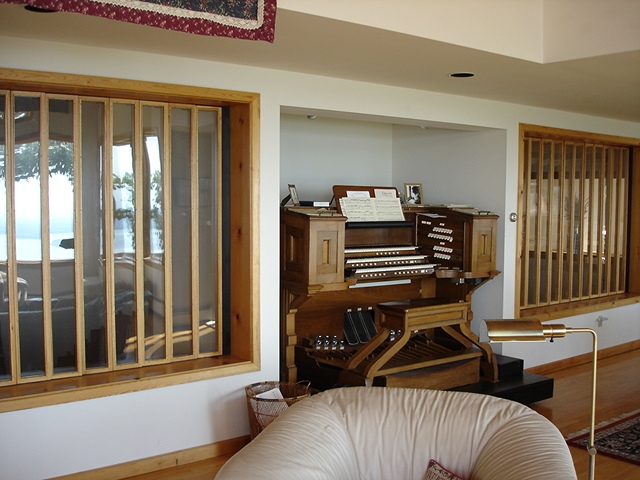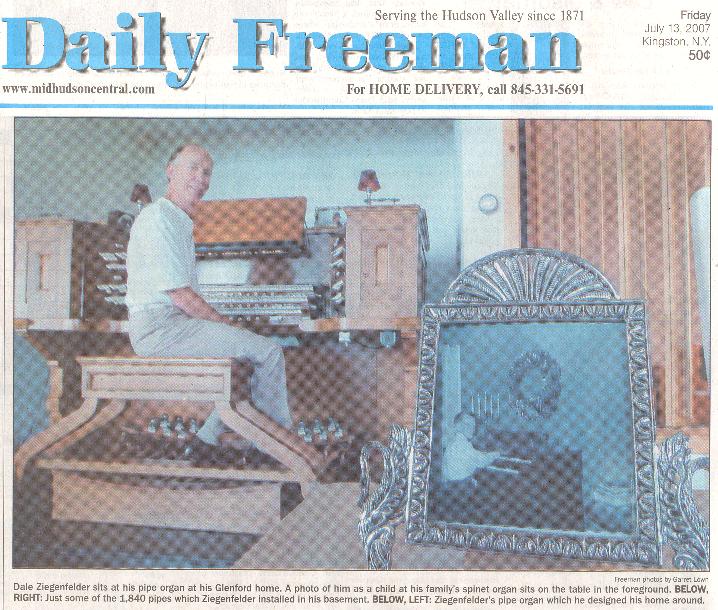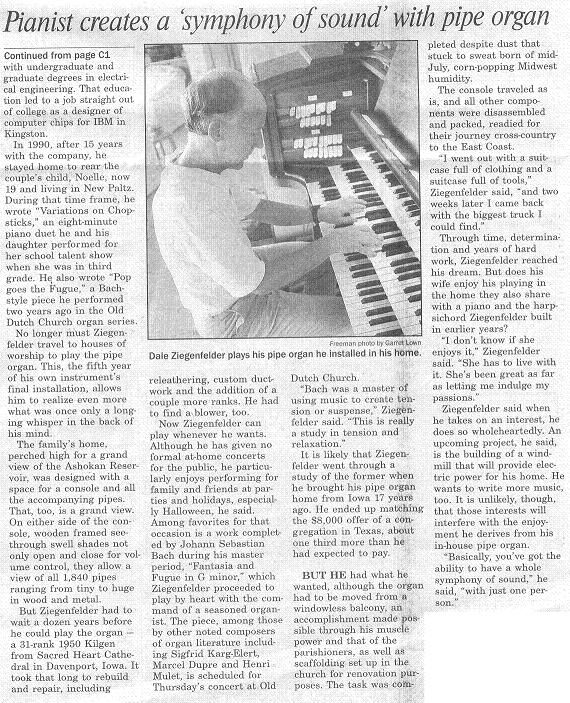Dale Ziegenfelder has completed the installation of the 3/33 1950 Kilgen organ #7401 from the Sacred Heart Cathedral in Davenport Iowa into his home in Glenford, New York.
Specifications
 The seed for this project was planted in my impressionable youth. As a teenage organ enthusiast in Cincinnati, Ohio, I heard about a theater organ installation in the home of John Strader from our TV repair man, obtained his phone number, called, and invited myself over for an evening. He had a two story addition built onto the living room end of his home, and had the Wurlitzer organ from the former Paramount Theater installed.
The seed for this project was planted in my impressionable youth. As a teenage organ enthusiast in Cincinnati, Ohio, I heard about a theater organ installation in the home of John Strader from our TV repair man, obtained his phone number, called, and invited myself over for an evening. He had a two story addition built onto the living room end of his home, and had the Wurlitzer organ from the former Paramount Theater installed.
The ornate console, surrounded with swell shades covered by a scrim on both sides was featured in the living room, and two pipe chambers extended upward from the basement. I suspect I thoroughly wore out my welcome after several hours of enthusiastic touring and playing, , but I left lastingly impressed by the experience.
Years later, Diana, my wife, and I were ready to build a home on a special tract of land we purchased. The challenge was to design sufficient space for an organ, take advantage of southern solar exposure, optimize a view, locate the organ so that tuning would be minimally affected by heat changes, and stay within a budget. A second visit to the Strader home was arranged to understand organ chamber design considerations. I built a cardboard model of the home-to-be to help with visualizing our space and layout ideas. The result was the realization that I needed some help, so we engaged John Wasylyk who produced a pleasing design and plans.
The design provided for two thirteen foot square adjacent chambers on the north side extending from the crawl space through the second floor where the kitchen/dining room/living room/master bedroom areas were located. A niche extending into the upper area of both chambers at the living room floor level provided space for the console to be presented to the living room. On both sides of the console niche, openings across the width of the chambers were left for swell shades. Stairways on both sides of the chambers have windows overlooking the chambers. A window in the wall separating the chambers allows an observer in a stairway to see though both chambers to the other stairway. A cathedral ceiling in the living room allowed for an ample volume of air for the sound to project into, and for loft space above the organ chambers.
For acoustic efficiency, the chamber walls were constructed of cement block with a concrete parget. The floor was concrete, and the ceilings were curved at the rear to help project the sound outward. Entry to the west chamber is through a door and down a ladder from the first floor below the console niche. A door under the niche connects the east and west chambers. Plastic drainage pipe was used to conduct the console umbilical cord and other wiring through the chamber separation wall from the console niche floor to the relay locations in the lower chambers.
Once the construction and moving in was complete, the hunt was on. After more than a year, the subject organ was located through an ad in "The Diapason". After reviewing the stoplist and making phone inquiries, I decided this was “it”, and flew out on a one-way plane ticket with two suitcases full of tools. The cathedral graciously provided room and board.
Working in a gallery in the corn belt at end of July and beginning of August with no windows is not an ideal situation. Fortunately, the cathedral provided fans. I constructed crates, begged packing material, and after two weeks of sixteen hour days and lots of sweat, had everything disconnected and packed. As a rank organ neophyte I remembered how everything was set up as I took it apart. The contractors who were working on the cathedral renovations let me use their scaffold and chain falls. With my comealong and help from lots of parishioners, the pipe crates, wind chests, reservoirs, and console were lowered from the gallery. It took two more days to pack everything in the largest truck I could find, but there wasn't room for the blower, so I left it there. Two days later I was in Glenford.
Diana had arranged an "unloading party" for the next day. My friends unloaded while I built the movable console platform. A hand crank forklift was used to lift the console fourteen feet to the deck railing near the living room. Many hands helped it over the railing and onto the platform. Loose pipes were crammed in closets, garage, and crawl space. The windchests and pipe crates were lowered into the chambers.
The first project was releathering, which took about two years due to "real world" work and family interruptions. On another visit to Cincinnati, I found a free one HP Spencer Orgoblo and a 16` Octave Bass (resulting in another truck ride back to Glenford with the car in tow). The Orgoblo was "souped up" to three hp, and set it up in the furnace room, adjacent to the wind line opening to the chambers. Linkage was hooked up from the main reservoir to a wind damper, and sixteen inch diameter metal ductwork was assembled, connected, and sealed. The Octave Bass was releathered, rewired, and set up along the back wall of the east chamber. It required its own reservoir, which I constructed in the form of the others. At some point, I realized that the octave bass would add enough wind load to require a five hp motor. That and an efficient impeller were purchased and installed in the Orgoblo.
Next, I measured each wind chest and reservoir, and made a two level floor plan including wind duct connections. A set of Barton chimes had been obtained from Minnesota. It was re-wired, and set up in the loft. Before setting up the wind chests, the pipe crates had to be removed from the chambers to two other rooms by individually removing and repacking the pipes.
Diana arranged and hosted the organ raising party. My friends returned to help set up the four big unit chests on their legs which were doweled into floorboards. I secured the unit chests to walls, and connected their reservoirs. The custom ductwork was extended from the main reservoir through both chambers and connected to all the reservoirs. The offset chests were installed. The blower was turned on, the reservoirs were adjusted for the correct pressure, and air leaks were repaired. A duct for the chimes was run through the loft floor, down the corner of the west chamber and connected.
I used my electronics engineering background to layout and build a power supply and an electronic relay board to replace the Kilgen electropneumatic boxes. I estimate there were about five wires for each of the 1800 or so pipes. The board was mounted near the exit of the console wiring duct in the west chamber, and the wires from the console soldered in place. Smaller boards for the Great and Choir were positioned similarly in the east chamber. This work required two years to complete.
It was desired to have see-through swell shades. George Barthel, a woodworking hobbyist friend of mine helped me cut twenty-four swell shade frames out of red oak to hold double Plexiglas panels. The cutting, milling, finishing, and assembling was another two year project. The swell shades were designed to fit the original mounting frames, which were sized and attached to the openings. The shades were installed using the original swivel arms and connected to the original swell motors.
The challenge of attaching the old windchest wires to the electronics connectors was met by hand soldering each wire to a ribbon cable strand, covering the connection with a piece of heat shrink tubing, and securing the ribbon cable to the appropriate gender connector. Dorcinda Knauth, an organ and history major at Lebanon Valley College gave up quite a few evenings of her summer to help with this tedious task.
Having completed the link from the keyboard to the windchests, the function of all the pneumatics and electronic wiring was checked out, and lots of problems were corrected. Dorcinda returned for a second summer to help with the debugging and problem correction. I discovered that the octave bass had cracks in several pipes. They all had to be removed to repair them.
Blower noise was quite noticeable, so some sound baffling and damping was installed. An insulated box was constructed around the blower for sound proofing and to ensure that the air for the organ came from the chambers themselves, not the furnace room, to keep a more constant temperature. The organ was now ready for its pipes.
Each pipe was cleaned and checked for damage and function then put in place. George volunteered a lot of help with this. Another summer arrived, and Dorcinda put in some time during the month she was available after graduation. Janusz Lasota, a pipe maker who has a shop in Highmount, NY, helped with the voicing of the trombone and trumpet, and repaired some damaged pipes. Missing pipes were replaced. After tuning, one last problem of isolating different voltages in the combination action surfaced and was solved.
We hosted the organ celebration during the Christmas holidays for friends and workers who helped over the twelve and a half years of the installation project. Terry Earles, an organist friend from the area, played works by Bach, Pachebel, Lao, Karg-Elert, D’Aquin, Soler, Cook, and Reger. I played works by Mushel, Yon, Vaughan Williams, Bach, Tournemire, and Widor.



 The seed for this project was planted in my impressionable youth. As a teenage organ enthusiast in Cincinnati, Ohio, I heard about a theater organ installation in the home of John Strader from our TV repair man, obtained his phone number, called, and invited myself over for an evening. He had a two story addition built onto the living room end of his home, and had the Wurlitzer organ from the former Paramount Theater installed.
The seed for this project was planted in my impressionable youth. As a teenage organ enthusiast in Cincinnati, Ohio, I heard about a theater organ installation in the home of John Strader from our TV repair man, obtained his phone number, called, and invited myself over for an evening. He had a two story addition built onto the living room end of his home, and had the Wurlitzer organ from the former Paramount Theater installed.


